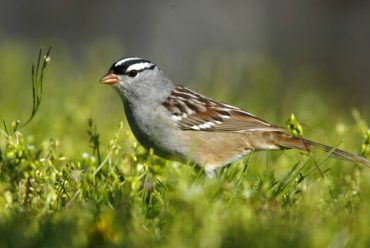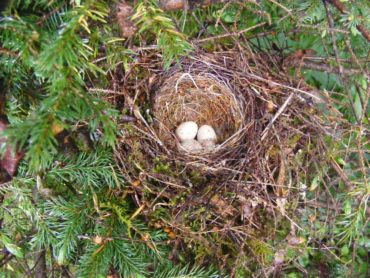
A limited number of birds nest in birdhouses. Most of those attracted to feeders, as well as those that aren’t, choose nest sites other than a man-made birdhouse. Robins are one of these. They do, however, often choose a nest site within close proximity to human dwellings.
Robins are not cavity-nesting birds. Birds that nest in birdhouses are cavity nesters. This is what they look for in the wild and birdhouses resemble what they are looking for. Most other birds prefer other types of habitat.
Robins and other members of the thrush family build their nests on horizontal surfaces, dense evergreen shrubs and trees. Once winter has stripped the leaves from the trees, nests built by both crows and robins stand out among the bare branches.
Despite the slap-dash way robins construct their nests, they will weather the worst winter storms. Early in the spring, the female begins nest construction and in a few days, the project is finished.
She will grab great chunks of grass, weeds, small sticks and even clumps of wet leaves and pile them onto a chosen tree branch, trellis, porch light or exposed beam. It may look like a damp and uncomfortable place to lay her eggs but it will be lined with dry grasses, lichen and moss. Robins will raise two families every year.
Chickadees and nuthatches readily move into birdhouses and build cozy nests. Birdhouses resemble the tree cavities or abandoned woodpecker nest sites they use in the wild. The larger birds dig out holes for their own nests and the smaller birds use them once they are vacated.
Flickers, downy and hairy woodpeckers will nest in birdhouses but there is a problem. More aggressive birds like the starlings and house sparrows often take them over, especially in urban or even suburban settings. Woodpeckers may call and drum while establishing their nesting territory but it will be in a location where it isn’t easily found.

Many ground-feeding birds are species that nest near the ground. Juncos, song sparrows, white-crowned sparrows and towhees choose the dense shrubs, tangled vines, thickets or hedges a yard may provide. Juncos are notorious for building nests in plant displays found in large box stores and local nurseries. Oftentimes, when this is discovered, the employees place a sign in the vicinity. The words “birds nesting” warn customers.
Such an event is an illustration of the fact that there are never enough nesting places to satisfy the nesting bird population. There is even a term for this and it refers to the birds that haven’t established a nesting territory. This is the “floating population” of birds looking for a place to nest. The spring battles for territory are evidence that other birds want what another bird has or is trying to hang onto.
White-crowned sparrows are common nesting birds throughout the West Sound region. They can be heard singing their familiar “see, see, oh I am so pret-tee” in the middle of shopping centers as well as in urban and rural areas. Landscaping that incorporates thick hedges, clumps of spirea and even wild roses attracts nesting white-crowns.
The spotted towhee that scratches so industriously under the feeders all fall and winter will build its nest just inches from the ground. Cotoneaster plants are a popular plant used in commercial landscaping. They are also popular in many home gardens. When a pair of towhees decides to build in these thick and scratchy plantings, the call “tow-eee” announces these ground-nesting birds have moved in.
House finches are among the most common birds attracted to feeders but they won’t nest in birdhouses. They are like the robin because they also seem to be drawn to human habitation.
Hanging baskets appeal to both house finches and juncos when they choose where they will build their nests. Window planters are also popular. When a nest is discovered, it is usually too late to stop the nesting birds from taking over.
At this time of the year, some West Sound residents will be trying to keep their plants alive and accommodate nesting birds. Careful watering becomes a challenge but it is possible to achieve both goals.
The warm temperature of May and June means the arrival of additional birds looking for nesting territories. These “summer birds” are the colorful neotropical species that migrate northward to nest. These summer visitors do not nest in birdhouses. Instead, they will build their nests in the habitat they prefer.
Throughout the West Sound as well as the entire Northwest, the lush summer foliage as well as the evergreen trees and plants will accommodate these nesting birds. Western tanagers, black-headed grosbeaks, vireos, warblers, flycatchers and the rufous hummingbirds will be raising families.
Different habitat will attract different species. Knowing what they prefer is a clue as to where they may raise a family.























Comments